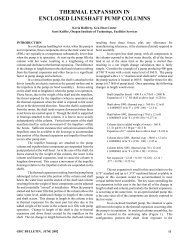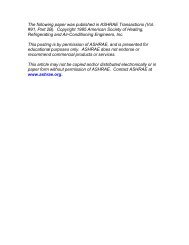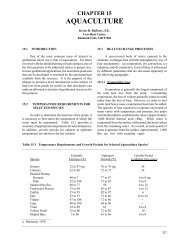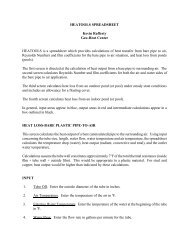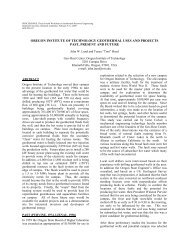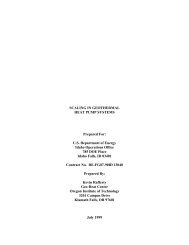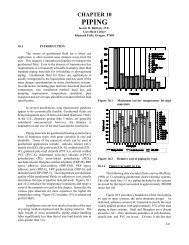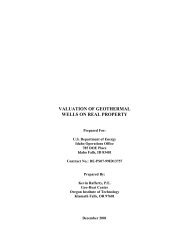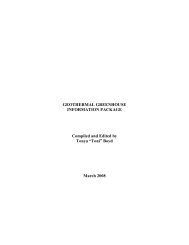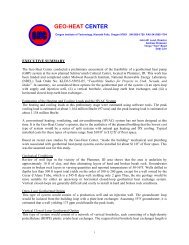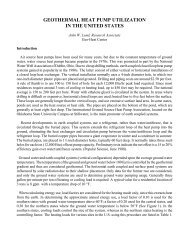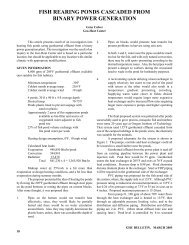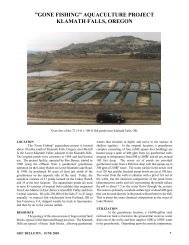Companion Study Guide on Short Course on Geothermal ... - OSTI
Companion Study Guide on Short Course on Geothermal ... - OSTI
Companion Study Guide on Short Course on Geothermal ... - OSTI
Create successful ePaper yourself
Turn your PDF publications into a flip-book with our unique Google optimized e-Paper software.
Table 1. Principle Effects of the Key Corrosive Species<br />
Key Corrosive Species Principle Effects<br />
Oxygen Extremely corrosive to carb<strong>on</strong> and low allow steels. 30 ppb* shown to cause four-fold<br />
increase in carb<strong>on</strong> steel corrosi<strong>on</strong> rate.<br />
C<strong>on</strong>centrati<strong>on</strong> above 50 ppb cause serious pitting.<br />
In c<strong>on</strong>juncti<strong>on</strong> with chloride and high temperature, less than 100 ppb dissolved oxygen<br />
can cause chloride-stress corrosi<strong>on</strong> cracking (chloride-SCC) of some austenitic stainless<br />
steels.<br />
Hydrogen i<strong>on</strong> (pH) Primary cathodic reacti<strong>on</strong> of steel corrosi<strong>on</strong> in air-free brine is hydrogen i<strong>on</strong><br />
reducti<strong>on</strong>. Corrosi<strong>on</strong> rate decreases sharply above pH 8.<br />
Carb<strong>on</strong> dioxide species<br />
(dissolved carb<strong>on</strong> dioxide,<br />
bicarb<strong>on</strong>ate i<strong>on</strong>, carb<strong>on</strong>ate i<strong>on</strong>)<br />
Hydrogen sulfide species<br />
(hydrogen sulfide, bisulfide i<strong>on</strong>,<br />
sulfide i<strong>on</strong>)<br />
Amm<strong>on</strong>ia species<br />
(amm<strong>on</strong>ia, amm<strong>on</strong>ium i<strong>on</strong>)<br />
Low pH (less than about 5) promotes sulfide stress cracking (SSC) of high strength<br />
low alloy (HSLA) steels and some other alloys coupled to steel.<br />
Low pH may cause breakdown of passivity of stainless steels.<br />
Acid attack <strong>on</strong> cements.<br />
Dissolved carb<strong>on</strong> dioxide lowers pH, increasing carb<strong>on</strong> and HSLA steel corrosi<strong>on</strong>.<br />
Dissolved carb<strong>on</strong> dioxide provides alternative prot<strong>on</strong> reducti<strong>on</strong> pathway, further<br />
exacerbating carb<strong>on</strong> and HSLA steel corrosi<strong>on</strong>.<br />
May exacerbate SSC.<br />
Str<strong>on</strong>g link between total alkalinity and corrosi<strong>on</strong> of steel in low-temperature<br />
geothermal wells.<br />
Potent cathodic pois<strong>on</strong>, promoting SSC of HSLA steels and some other alloys coupled<br />
to steel.<br />
Highly corrosive to alloys c<strong>on</strong>taining both copper and nickel in any proporti<strong>on</strong>s.<br />
May cause an (active path) chloride-sulfide-SCC of nickel-based alloys at high<br />
temperatures.<br />
Causes SCC of some copper-based alloys.<br />
Chloride i<strong>on</strong> Str<strong>on</strong>g promoter of localized corrosi<strong>on</strong> of carb<strong>on</strong>, HSLA, and stainless steels as well<br />
as of other alloys.<br />
Chloride dependent threshold temperature for pitting and SCC. Different for each<br />
alloy.<br />
Little if any effect <strong>on</strong> SSC.<br />
Steel passivates at high temperatures in pH 5, 6070 ppm chloride soluti<strong>on</strong> with<br />
carb<strong>on</strong> dioxide. 133,500 ppm chloride destroys passivity above 300 o F.<br />
Sulfate i<strong>on</strong> Primary effect is corrosi<strong>on</strong> of cements.<br />
* Parts per billi<strong>on</strong>



